CCHU9034
Final Video Essay
Director: 3036267197 Ning Yu Xuan
The Fallen Faith
Hung-Shing Temple
Video Link:https://youtu.be/bLa-5X1w1AY
The tale tells that in the Tang Dynasty (618AD–907AD), there was a man called Hung Hei, who was the alderman of Canton, also known as Guangzhou. Hung Hei was a Renaissance man who demonstrated proficiency in astronomy, geography and mathematics. He was renowned for his integrity and beneficial policies towards local people. It is said that he built an observatory to predict forthcoming weather in order to protect sailing fishermen. However, his endless tasks became a burden on his health, and he passed away due to overwork.
Hundreds of years later, during the Song Dynasty (1041AD), the Song Ren Emperor bestowed upon Hung Hei the name Hung Shing (which means Saint Hung Hei) in recognition of his contributions and regarded him as the God of the Southern Sea. People around Guangzhou, especially fishermen, prayed to Hung Shing for calm weather and smooth sailing. Some also believed that Hung Shing would gift them with an abundant fish harvest.
Hung Shing Temple serves as an important spiritual and cultural center for traditional Chinese folk beliefs in Hong Kong’s rural areas. As of 1949, it was believed that there were over 500 Hung Shing Temples in Guangdong. However, by 2000 there were less than 200 remaining. The falling levels of faith stemmed from multiple reasons. Firstly, as the number of the fishing population significantly decreased, coastal communities no longer demanded smooth sailing or abundant harvests to the same extent and thus prayed to Hung Shing less frequently. Secondly, a growing educated populace altered ideologies, as modern values tend to view matters through the lens of science and believe more in materialism than folk beliefs. Hence, the decline of traditional faiths appeared inevitable.

One of the remaining Hung Shing Temples that remains popular is located on Tai Wong Street East in Wan Chai. The temple was built in 1847 and is now a Grade I historic building managed by Tung Wah Groups of Hospital (TWGHs, n.d.). Situated in the heart of Wan Chai, the Temple is surrounded by tall modern structures yet directly adjoins the main thoroughfare. As such, it remains an attraction for both tourists and passers-by in the midst of the city surroundings.
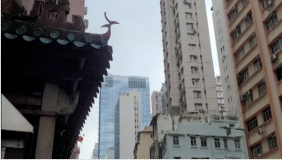

In the very beginning of the video, the scene moves slowly from sky to the street, showing the surrounding of the temple which constructs a strong comparison. One the left of the screen, it is Hung Shing Temple, which was built in 1800s, on the right, its modern Hong Kong street view. At the middle, there are people and cars passing by, indicating the bustling city.
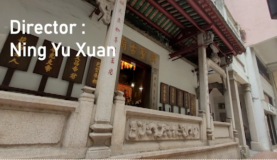
The third scene is shot from bottom left diagonally to the top right corner of the main entrance of Hung Shing Temple. This technique makes the gate of Hung Shing Temple look more solemn and oppressive (Garcia, 2008). In order to emphasis the role of Hung Shing as a god, the camera was put as low as it could. Therefore, audiences are in a role of submission to the god.
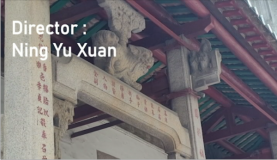
The following scene is a close-up of the stone carving and the gate pillar. One of the characteristics of ancient Chinese temple is the carving of different legendary creatures and exaggerated eaves (Chan, 2005). Besides, there are Chinese words carved on the stone pillar, recording the history of the temple. The purpose of adding this scene is to show how this building is different from modern structure, and to discover the beauty of ancient buildings.

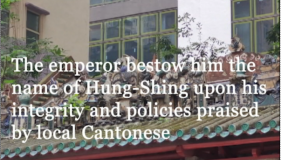
The following scene is the close-up of the roof. As the image has shown, there are stone carving of dragons and gods on the roof. Traditional Chinese sacrificial objects and religion building always have carving of dragons and phoenix on it, Chinese believe that the carving of these mythical creatures is the signature of stability and prosperity of the country (Xu, 1994). Another characteristic of Chinese building is the joint designs of multiple wooden members (Goldberg, 1983). The wooden supports of the roof were not connected by glues nor nails, but the unique shape for embedding.


The following scene shows people praying to Hung Shing with incense sticks. It is believed that the incense stick contains power that could communicate to the god (Zhang, 2006). In this scene, only three people praying dumbly to Hung Shing. However, the road outside is very busy in previous scenes. This hints that Hung Shing Temple is not very popular, when compared to the crowded city. But there are still some followers who would pray to Hung Shing. They wear modern clothes, walk into the ancient temple, the uncoordinated combination indicates the chemistry between tradition and modern values.
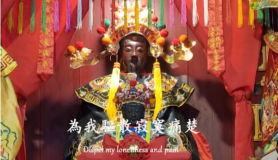
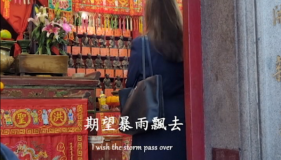
Lyrics were added to the background music in these scenes. With a close-up of Hung Shing’s statue, the lines “Dispel my loneliness and pain” and “I wish the storm pass over” serve to illustrate how Hung Shing was believed to bless his followers with happiness, prosperity and safe passage, seeing them through hardship and granting respite from life’s challenges.
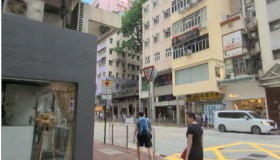

The final scene mirrors the opening by shifting the camera’s gaze from the temple back up to the sky, echoing the cyclical nature of time. The diminutive temple, when viewed alongside the lofty towers reaching for the heavens, creates a striking visual juxtaposition. Hung Shing Temple stands alone amidst the modern urban surroundings, much like traditions grappling to endure within contemporary culture. Whether this sacred site will withstand the test of time remains to be seen, as the city continues its rapid development. Only time will tell if the temple perseveres.
Reference:
1.Tung Wah Groups Of Hospitals, (n.d.) https://temples.tungwahcsd.org/hung-shing-temple-wanchai
2.Alvarado, R. G. (2008). Analysis of Filmmaking Techniques for Architectural Animations. ODTÜ Mimarlık Fakültesi Dergisi, 25(2), 133–149. http://jfa.arch.metu.edu.tr/archive/0258-5316/2008/cilt25/sayi_2/133-149.pdf
3.Chan, S. C. (2005). Temple-Building and Heritage in China. Ethnology, 44(1), 65–79. https://doi.org/10.2307/3773960
4.Goldberg, M. Y. (1983). Greek Temples and Chinese Roofs. American Journal of Archaeology, 87(3), 305–310. https://doi.org/10.2307/504798
5.徐自強, & 吳夢麟. (1994). 中國的石刻與石窟 (初版)(Chinese Stone carving and stone cave). 臺灣商務印書館(Taibei shi : Taiwan shang wu yin shu guan).
6.X. Zhang. (2006). 香之為物:進香儀式中香火觀念的物質基礎. 台灣人類學刊, 4(2), 37-73.
7.C. T. Lai. (2021). A Complete Collection of Stele Inscriptions in Hong Kong Temples, The Chinese University of Hong Kong Press